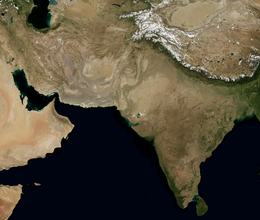
Back جغرافيا باكستان Arabic Xeografía de Paquistán AST Pakistan coğrafiyası Azerbaijani Геаграфія Пакістана Byelorussian География на Пакистан Bulgarian पाकिस्तान के भूगोल Bihari পাকিস্তানের ভূগোল Bengali/Bangla جوگرافیای پاکستان CKB Coğrafyay Pakıstani DIQ Geografía de Pakistán Spanish
This article needs additional citations for verification. (November 2019) |
 | |
| Continent | Asia |
|---|---|
| Region | South Asia, Indian subcontinent |
| Coordinates | 30°00′N 70°00′E / 30.00°N 70.00°E |
| Area | Ranked 33rd |
| • Total | 881,913 km2 (340,509 sq mi) |
| • Land | 97.14% |
| • Water | 2.86% |
| Coastline | 1,046 km (650 mi) |
| Borders | Total: 7,307 km (4,540.4 mi) Afghanistan: 2,670 km (1,659.1 mi) China: 559 km (347.3 mi) India: 3,320 km (2,063.0 mi) Iran: 959 km (595.9 mi) |
| Highest point | K2 8,611 m (28,251 ft) |
| Lowest point | Indian Ocean 0 m (0.0 ft) |
| Longest river | Indus River |
| Largest lake | Manchhar Lake |
| Exclusive economic zone | 290,000 km2 (110,000 sq mi) |
The Geography of Pakistan (Urdu: جغرافیۂ پاکِستان) encompasses a wide variety of landscapes varying from plains to deserts, forests, and plateaus ranging from the coastal areas of the Indian Ocean in the south to the mountains of the Karakoram, Hindukush, Himalayas ranges in the north. Pakistan geologically overlaps both with the Indian and the Eurasian tectonic plates where its Sindh and Punjab provinces lie on the north-western corner of the Indian plate while Balochistan, most of Khyber Pakhtunkhwa, and Gilgit-Baltistan lie within the Eurasian plate which mainly comprises the Iranian Plateau and the Tibetan Plateau in the north.
Pakistan is bordered by Iran to the west, Afghanistan to the northwest, China to the northeast, India to the east, and the Arabian sea to the south. Geopoltically, the nation is situated within some of the most hostile regional boundaries, characterized by territorial disputes and historical tensions, particularly the Kashmir conflict with India, which has led to multiple military confrontations between the two countries.
Pakistan's western borders include the Khyber Pass and Bolan Pass that have served as traditional migration and trade routes between Central Eurasia and South Asia, serving as conduits for cultural exchanges, military invasions, and commercial activity for centuries.